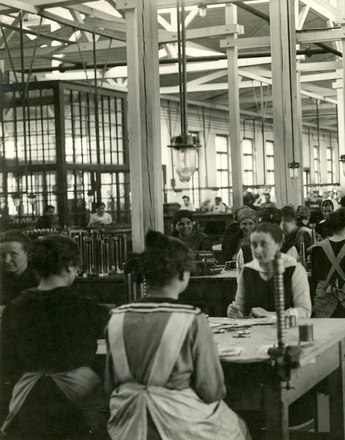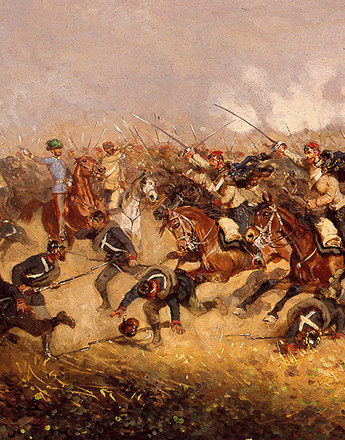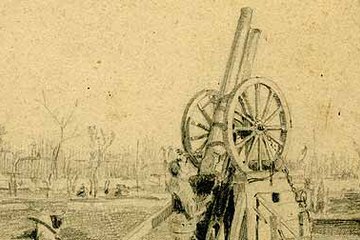From the Lorenz Gun of Königgrätz to the Ordnance Weapon M1895
Right up to the mid 19th century soldiers of the Austrian Imperial Army were equipped with manufactured muzzle-loading guns. Despite their ballistic advantages they were at a disadvantage compared to the newly developed breech-loaders: to reload the gun the soldiers had to stand up from their cover.
The battle of Königgrätz (1866) painfully brought home to the Habsburgs that compared to the Prussians they were not only inferior organisationally but also technically. In this battle it became apparent that the Prussian breech-loaders were vastly superior – if not ballistically then still tactically – to the Austrian muzzle-loaders. The fact that the Austrian muzzle-loaders outranged the breech-loaders significantly was of little relevance in this battle as the Prussians never left their cover. Whilst the Austrians had to reload their muzzle-loaders in an upright or at least kneeling position – making them perfect targets – the German fusiliers could prepare the next shot of their needle rifles lying down. Also, the reloading of the new guns was a much quicker process, which allowed for a faster rate of fire. Thus the needle rifle that was developed by Johann Nikolaus von Dreyse (1787 – 1867) and introduced to the Prussian Army in the late 1840s had an important impact on military tactics. The military historian Fritz H. Baer comments on this: "The introduction of breech-loaders […] set in motion a development which was to lead to a fundamental change in the image of war. […] The time of strike tactics with bayonet attacks had come to an end just like the time of the muzzle-loaders had – as the military actions of 1866 with the fatal consequences for the Austrian Imperial Army had shown."
Concerning the development and production of handguns the battle of Königgrätz had two implications for the Austro-Hungarian Empire: on the one hand, muzzle-loaders were to be replaced by breech-loaders as soon as possible; on the other hand many more such guns were needed for the tremendously enlarged army which had increased in numbers due to the introduction of general compulsory military service in 1868.
Already in the summer of 1866 a specially founded commission decided to convert the muzzle-loading Lorenz guns that had been in use up to that time with percussion initiation to breech-loaders. The commission decided on the converted version presented by the Viennese gunsmith Karl Wänzel. However, this adaptation remained but a short provisional solution. Already in 1867 the commission chose the concept of the two gun engineers Karel Holub (1830-1903) and Josef Werndl (1831-1889). Their concept was highly innovative for two reasons: it was the combination of the newly developed so-called tabernacle breech and an industrialised production that helped the 'Oesterreichische Waffenfabriks-Gesellschaft' (OeWG) in Steyr to make extremely precise, reliable guns that were relatively cheap to produce. The gun produced as M1867 since 1867 was also a huge success economically which lead to the OeWG rising to become one of the largest producers of hand guns in Europe. The different models of the M1867, which in subsequent years was repeatedly modified and improved, constituted the standard gun for ground forces in the years to follow.
The next big stage of development was the M.1885, constructed by Ferdinand von Mannlicher (1848-1904), a repeating rifle. The ammunition clip fitted in the middle of the stock meant that one did not have to reload the gun after every shot, but could fire off multiple shots before having to reload the ammunition clip. This gun was also produced in Steyr as well as in the Budapest branch and was introduced to the Imperial Army in 1886. This particular model was also the basis for modified and improved versions in the years to follow. The final version (albeit temporarily) was formed by the Steyr-Mannlicher-Model M.1895, produced over three million times in the years leading up to the First World War. It was considered to be an excellent rifle owing to its reliability, precision and high rate of fire and was, next to its predecessor models, the M.1888 and M.1890, the most widely used rifle in the First World War. The planned further development of the M.1915 was not carried out any more due to the war.
Baer, H. Fritz: Die Erzeugung der Handfeuerwaffen in Österreich im 19. Jahrhundert am Beispiel der Firma Werndl in Steyr, in: Foerster, Roland G./Walle, Heinrich (Hrsg.): Militär und Technik. Wechselbeziehungen zu Staat, Gesellschaft und Industrie im 19. und 20. Jahrhundert, Herford 1992, 123-160
Bowen, Hannah (Red.): Militärgeschichte. Waffen und Kriegsführung von der Antike bis heute, München 2013
Ortner, M. Christian: Die k. u. k. Armee und ihr letzter Krieg, Wien 2013
Willmott, P. Hedley: Der Erste Weltkrieg, München 2009
Quotes:
"The introduction of breech-loaders...": Baer, H. Fritz: Die Erzeugung der Handfeuerwaffen in Österreich im 19. Jahrhundert am Beispiel der Firma Werndl in Steyr, in: Foerster, Roland G./Walle, Heinrich (Hrsg.): Militär und Technik. Wechselbeziehungen zu Staat, Gesellschaft und Industrie im 19. und 20. Jahrhundert, Herford 1992, 131 (Translation)
-
Chapters
- Explosive Discoveries. From Gunpowder to TNT
- From the Lorenz Gun of Königgrätz to the Ordnance Weapon M1895
- Artillery I.: Technical Innovation and late Modernisation
- Artillery II: The Creeping Barrage, Barrage and Curtain Fire
- The high rate of fire of the machine gun: concerning the Mitrailleuse, the Gatling Gun, the Maxim Gun and the Schwarzlose MG
- An Effective Addition: Hand Grenades and Mortars
- The Imperial Arms Industry





